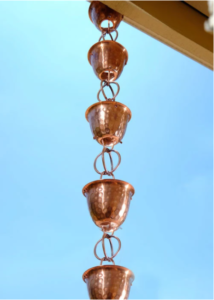Throughout north Texas, rainwater harvesting takes all shapes and sizes. Your dream system
may include stainless steel cisterns or wooden gutters, but there are practical options for any
budget. As the climate shifts into the cooler months, September and October bring a chance for
autumn storms. Oftentimes, residential dwellings may not have access to an entire roof for rain
catchment. When this occurs, heavy runoff culminates at corners of the structure, and usually
causes damage to soil and vegetation below. This is the perfect location for a rain chain.
Rain chains function as an alternative to downspouts, allowing rainwater to pass along decorative
baubles and cups down to a cistern below. This means a downspout can accentuate your outdoor
area, while conserving rainwater. Their origins date back to 1,600 years ago, when the sukiya
architectural style seen frequently in Japanese tea houses, first became prominent.
Kusari toi installation encourages vertical irrigation, while providing the pleasant aesthetic of
running water. The 1998 Winter Olympics in Nagano, Japan, first showcased the hardware to
millions of viewers all over the world. Since then, chains have remained a popular staple in
garden and feed stores.
How long should your rain chain be? Approximately 8.5 feet works for most American single story buildings. Materials for rain chains range from wood to metal, but popular recent models feature copper that develops a beautiful hue from chemical weathering as time goes on. Add an additional layer of conservation to your garden by placing native plants or potted varieties around the chain to utilize excess water. While some rain chains may function purely as
decoration, we encourage those with lily & scallop design cups to conserve more water.
Depending on the materials the rain chain is constructed of, trace amounts of excess metals may
leach into your collected water, including copper and aluminum. However, metals avoid the risk
of algae or bacterial growth within your system, whereas wooden structures are prone to this type
of growth if not properly treated prior to installation.
Regarding installation, A “V” or gutter hook easily attaches the chain inside of a gutter hole.
Thoroughly cleaning your gutter system and harvesting cistern reduces the likelihood of algae
and coliform growth, as well as nasty mosquito larvae (your amphibious garden visitors may be
fans though).
UTGCD always recommends treating harvested water to avoid injury and infection. Whether
you are planning for your spring garden this fall or looking to create a tranquil space on your
porch, consider rainwater harvesting.
For more information and recommendations on rainwater harvesting, contact the Upper Trinity
Groundwater Conservation District’s Education & PR Coordinator, Jill Garcia, at
jill@uppertrinitygcd.com


